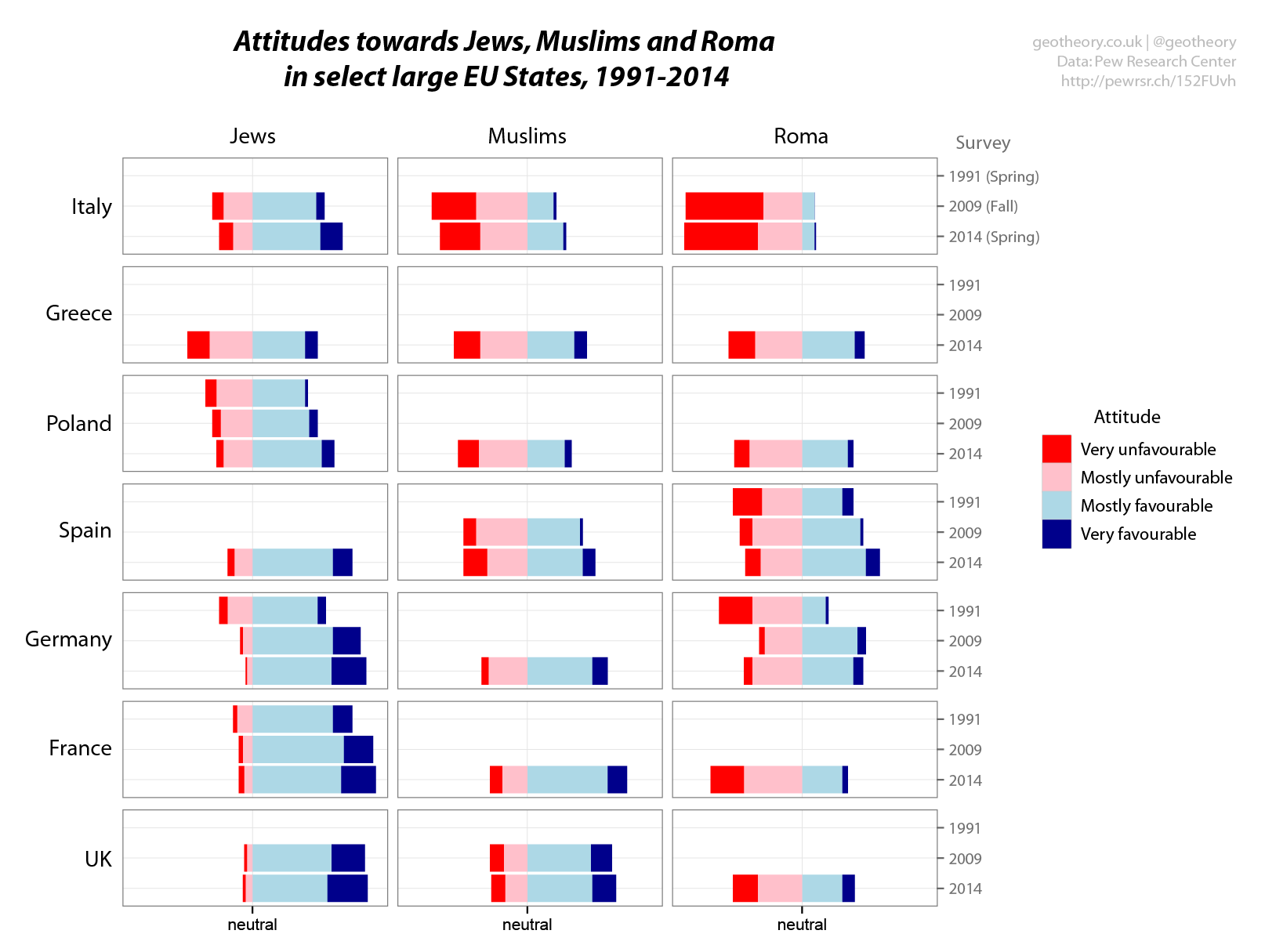European attitudes towards certain minority groups are currently under much scrutiny in the wake of Israel’s recent military action in Gaza and particularly the Charlie Hebdo attack in Paris two weeks ago. Speaking yesterday at an event commemorating the attack’s Jewish victims, British Home Secretary Theresa May announced an increase in funding to police against anti-semitism. In France police have been deployed to protect Jewish schools. There’s also growing evidence of a backlash against Muslim communities, such as the anti-Islam rallies held yesterday in Munich and Berlin in defiance of a police ban, and with a new rally planned in Dresden.
These debates surrounding these developments need to be informed by better data, such as that of a survey carried out in the last year by the Washington-based Pew Research Center. Pew undertook as part of their Global Attitudes Project a survey in March/April last year of attitudes towards some ethnic/cultural groups. Specifically they asked 7,022 adults from 7 EU countries – UK, France, Germany, Italy, Spain, Poland and Greece (72.5% of the total EU population) – the following question about their views towards (respectively) Jews, Muslims and Roma people:
Q37 I’d like you to rate some different groups of people in (survey country) according to how you feel about them. Please tell me whether your opinion is very favorable, mostly favorable, mostly unfavorable or very unfavorable.
The findings are complemented by previous surveys undertaken in Spring 1991 and Autumn 2009, which together offer a valuable insight into the general trends in race-relations from pre-internet days (views towards Muslims weren’t initially surveyed) as well as in light of more recent history. Importantly the survey misses the change in attitudes since Israel launched its military campaign in Gaza in July, but it remains an important piece of research to contextualise the present debates. The data are available in Pew’s May 2014 report. The report’s supporting graphics are well-presented, but as they omit the historical data and also aggregate the extreme and moderate opinions (both positive and negative) I felt it would be worthwhile having another go. The results is given here. The bars are horizontally centred between the ‘mostly’ categories to make vertical comparisons between countries clearer.
Identifying trends is a little complicated when dealing with 4 categories, so I’ve reduced these to a single ‘attitude score’ for each country-survey by converting the percentages to scores by assigning values to the categories as follows:
| ‘very unfavourable’ | -2 points |
| ‘mostly unfavourable’ | -1 point |
| ‘mostly favourable’ | +1 point |
| ‘very favourable’ | +2 points |
Then by summing the resulting scores for each country survey we can compare how attitudes trend in aggregate over time:
This gives us a good idea of how positive attitudes balance up compared to negative ones. The thick horizontal line mid-way up shows the line of ‘neutral’ attitudes, where positive and negative views are in equilibrium. Separately it’s useful to aggregate the surveys (maintaining the attitude categories) to show how attitudes summarise across the 7 countries by ethnic/religious group:
It’s clear from these that the attitudes towards Roma were the most negative for the surveys’ respondents in most countries, and especially Italy. In Greece, Poland and Spain negative attitudes towards Muslims were on a similar level. Overall more than twice the respondents held ‘mostly’ or ‘very’ unfavourable views towards Muslims than compared to Jews. The ‘current-day’ ratio of negative to positive respondent attitudes towards Jews in Germany, France and UK was also relatively small (perhaps surprisingly so) in comparison to other countries and for Muslims and Roma (although, again, these don’t factor for most recent trends). I’ll leave inferences and further interpretations to the reader, save to say that if these responses were indeed representative of wider popular attitudes, the report makes for interesting reading and I’d encourage everyone to have a look.
[Previously published at geotheory.co.uk]


